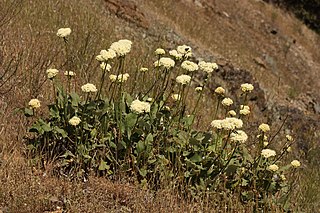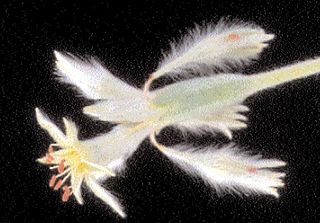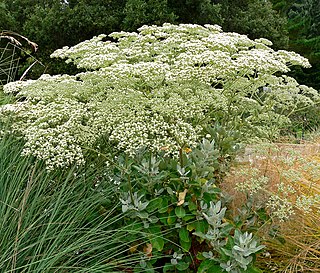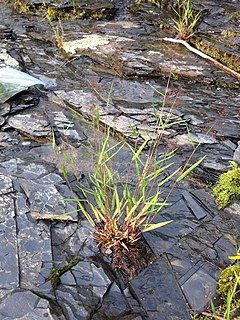
Eriogonum is the scientific name for a genus of flowering plants in the family Polygonaceae. The genus is found in North America and is known as wild buckwheat. This is a highly species-rich genus, and indications are that active speciation is continuing. It includes some common wildflowers such as the California buckwheat.
The common name umbrella plant can refer to several unrelated species:

Eriogonum nudum is a perennial shrub of the wild buckwheat genus which is known by the common name naked buckwheat or nude buckwheat.

Eriogonum fasciculatum is a species of wild buckwheat known by the common names California buckwheat and eastern Mojave buckwheat.

Oenothera lindheimeri, formerly Gaura lindheimeri, and commonly known as Lindheimer's beeblossom, white gaura, pink gaura, Lindheimer's clockweed, and Indian feather, is a species of Oenothera.

Eriogonum longifolium var. harperi, also known as Harper's buckwheat or Harper's umbrella plant, is a dicot of the family Polygonaceae, found in areas of nutrient-poor shale soils in Alabama, Kentucky and Tennessee. It lives inconspicuously in an immature vegetative stage for four or more years before developing a flowering stalk, then flowers and dies. It is listed as an endangered species by the state of Tennessee. It has eleven small populations in Alabama and five in Tennessee but its survival in Kentucky is uncertain. According to a leading expert, Professor James L. Reveal of the University of Maryland, its Kentucky population has been reportedly extirpated. Its 2006 Alabama Natural Heritage Program ranking was G4T2S1, demonstrating an opinion that it was "critically imperiled" in that state.

Opuntia engelmannii is a prickly pear common across the south-central and Southwestern United States and northern Mexico. It goes by a variety of common names, including desert prickly pear, discus prickly pear, Engelmann's prickly pear in the US, and nopal, abrojo, joconostle, and vela de coyote in Mexico.

Celtis lindheimeri, also called Lindheimer's hackberry, is a species of tree in the family Cannabaceae. It is typically found in areas of central Texas and northeastern Mexico. It has a height averaging 9 meters, and produces a reddish-brown berry. It is a species closely related to netleaf hackberry which is common in western United States. The Spanish common name is "palo blanco", meaning "white tree", which is commonly used to identify this tree. It is named after its discoverer Ferdinand Lindheimer, a German-born botanical collector and Texas newspaper editor.

Solanum ensifolium is a species of plant in the family Solanaceae endemic to Puerto Rico. Commonly known as erubia, it is nearly extinct due to habitat loss.

Eriogonum longifolium, the longleaf eriogonum or long-leaf wild buckwheat, is a dicot of the family Polygonaceae. In addition to populations of E. longifolium var. longifolium found in Arkansas, Kansas, Louisiana, Missouri, New Mexico, Oklahoma, and Texas, there are varieties or subspecies that are geographically isolated and at various levels of endangerment. According to the University of Michigan Native American Ethnobotony database, Eriogonum longifolium has been used as a food by the Kiowa and as a medicinal by the Comanche.

Eriogonum longifolium Nutt. var. gnaphalifolium Gand., commonly referred to as scrub buckwheat is a dicot of the Polygonaceae family. It is listed as threatened in the US and endangered in Florida. Within Florida its most closely related species is Eriogonum tomentosum however there are three other varieties of Eriogonum longifolium found in other areas of the US.

Eriogonum giganteum, with the common name St. Catherine's lace, is a species of wild buckwheat in Southern California.

Eriogonum ovalifolium is a species of wild buckwheat known by the common name cushion buckwheat. It is native to western North America from California to Alberta, where it is a member of many plant communities in varied habitats.

Eriogonum umbellatum is a species of wild buckwheat known by the common name sulphurflower buckwheat, or simply sulphur flower. It is native to western North America from California to Colorado to central Canada, where it is abundant and found in many habitats. This is an extremely variable plant and hard to identify because individuals can look very different from one another. Also, there are a great many varieties. It may be a perennial herb forming a small clump with flowers to 10 centimeters tall, or a sprawling shrub approaching two meters high and wide. The leaves are usually woolly and low on the plant, and the flowers come in many colors from white to bright yellow to purple. Native American groups utilized parts of this plant for a number of medicinal uses.

Eriogonum tomentosum, commonly referred to as dogtongue buckwheat or dogtongue wild buckwheat, is a species in the Polygonaceae family.

Euphilotes battoides, the square-spotted blue or buckwheat blue, is a species of butterfly of the family Lycaenidae. It is found in western North America from Washington south to Baja California Norte and then west to southern Colorado and New Mexico.
Muhlenbergia lindheimeri is a species of bunch grass, 3-6' H, known by the common names big muhly, blue muhly, and Lindheimer's muhly. It is native to North America, where it can be found in northern Mexico and up to the Edwards Plateau region of Texas. It is also grown as an ornamental grass. as it is useful as a green screen, erosion control, water retention and nest material for many species of birds

Dracophyllum longifolium, commonly called inaka, is an upright shrub or small tree in the family Ericaceae that is endemic to New Zealand.

Dichanthelium lindheimeri, commonly called Lindheimer panicgrass, is a species of flowering plant in the grass family (Poaceae). It is native primarily to eastern areas the United States and Canada, with its range extending into the South Central region. There are also outlying western populations in California, New Mexico and Oregon.

Perityle lindheimeri, commonly called Lindheimer's rock daisy, is a species of flowering plant in the aster family (Asteraceae). It is native to the United States, where it is endemic to the Edwards Plateau of Texas.















